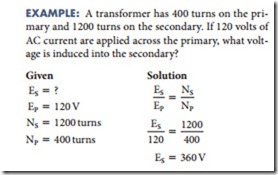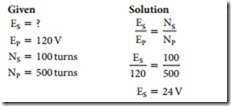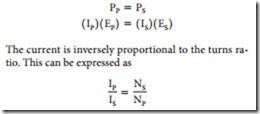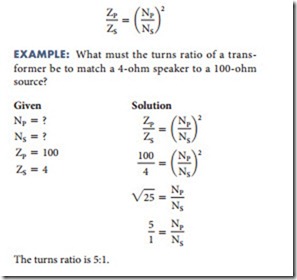turns ratio
The turns ratio of a transformer determines whether the transformer is used to step up, step down, or pass voltage unchanged. The turns ratio is the number of turns in the secondary winding divided by the number of turns in the primary winding. This can be expressed as:
A transformer with secondary voltage greater than its primary voltage is called a step-up transformer. The amount the voltage is stepped up depends on the turns ratio. The ratio of secondary to primary voltage is equal to the ratio of secondary to primary turns. This is expressed as
Thus the turns ratio of a step-up transformer is always greater than 1.
Example: A transformer has 400 turns on the pri- mary and 1200 turns on the secondary. If 120 volts of AC current are applied across the primary, what volt- age is induced into the secondary?
Given Solution
EXamPlE: A transformer has a 10:1 turns ratio. If the primary has a current of 100 milliamperes, how much current flows in the secondary?
A transformer that produces a secondary voltage less than its primary voltage is called a step-down transformer. The amount the voltage is stepped down is determined by the turns ratio. In a step-down transformer, the turns ratio is always less than 1.
Example: A transformer has 500 turns on the primary and 100 turns on the secondary. If 120 volts AC are applied across the primary, what is the voltage induced in the secondary?
Assuming no transformer losses, the power in the secondary must equal the power in the primary. Al- though the transformer can step up voltage, it cannot step up power. The power removed from the second- ary can never be more than the power supplied to the primary. Therefore, when a transformer steps up the voltage, it steps down the current, so the output power remains the same. This can be expressed as
An important application of transformers is in impedance matching. Maximum power is trans- ferred when the impedance of the load matches the impedance of the source. When the impedance does not match, power is wasted.
For example, if a transistor amplifier can efficiently drive a 100-ohm load, it will not efficiently drive a 4-ohm speaker. A transformer used between the transistor amplifier and speaker can make the impedance of the speaker appear to be in proportion. This is accomplished by choosing the proper turns ratio.
The impedance ratio is equal to the turns ratio squared. This is expressed as
Questions
1. What determines whether a transformer is a step-up or a step-down transformer?
2. Write the formula for determining the turns ratio of a transformer.
3. Write the formula for determining voltage based on the turns ratio of a transformer.
4. What is the secondary output of a transformer with 100 turns on the primary and 1800 turns on the secondary and 120 volts applied?
5. What is the turns ratio required to match a 10 kV source with a 600 V load.
Related posts:
Incoming search terms:
- transformer turns ratio formula
- transformer ratio formula
- transformer turns ratio
- turn ratio of a transformer
- What is the turns ratio of a transformer?
- transformer turn ratio formula
- what is the turns ratio for 8:8 load
- turn ratio of transformer formula
- turns ratio of transformer
- what turn ratio of transformers is required to match 4 ohm speaker to a transistor having an output impedance of 8000 ohm
- What is turn ration and transformation ration of trans
- What turn ratio (Np/Ns) of transformer is required to match 4 ohm speaker to a transistor having an output impedance of 8000 ohm?
- Transformer ratio
- formulas for transformers calculation
- The maximum turns ratio for the step up transformer is?
- turns ratio of a transformer a IS GREQTER THEN 1
- Turns ratio of transformer of impedance ma
- formula of transformer turns ratio
- Turns ration for a C T is n = Np ⁄ Ns n = Ns ⁄ Np n = 1 ⁄ Np n = Ns
- Turns ration for a C T is _________
- What is the formula for transformer turns ratio?
- what is the turn ratio of a transformer
- how much the turn ratio to mach 4 ohm speaker to 10 ohm sources
- formula for turns ratio of a transformer
- formula for the turns ratio of the transformer
- what is turns ratio of transformer
- explain the turns ratio of a transformer
- turn ratio of transformer less than 1
- power ratio and turns
- transformer ratio impedance
- transformer ratioformula
- transformer turn formula
- Tranformer tu
- TRANSFORMER TURNS
- transformer turns formula
- Transformer turns ratio and losses
- scientific formula of transformer turn ratio
- transformer turns ration
- transformer turns ration formula
- turn ratio formula
- turn ratio formula transformer
- ratio of source impedance
- Turns ration for a C T is * 1 point n = Np ⁄ Ns n = Ns ⁄ Np n = 1 ⁄ Np n = Ns





